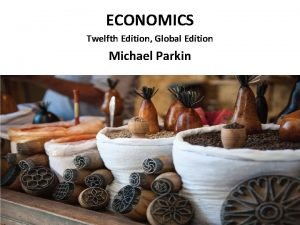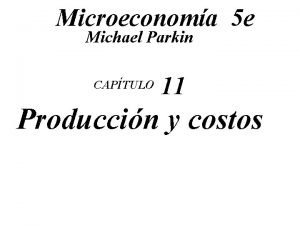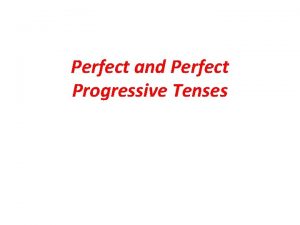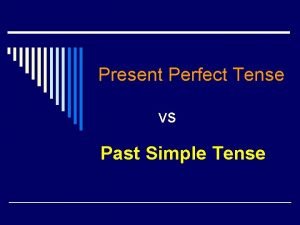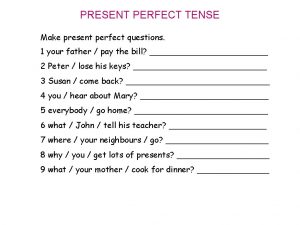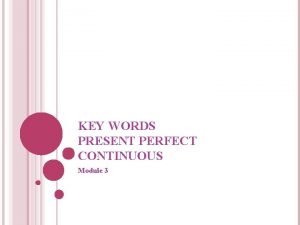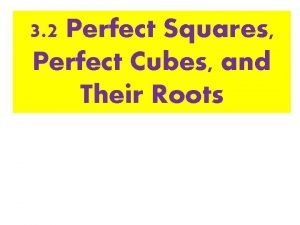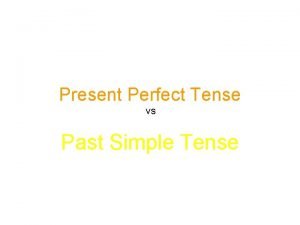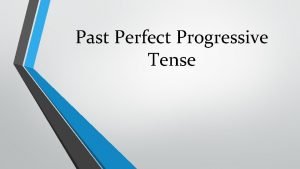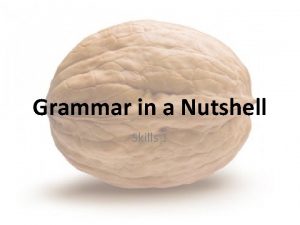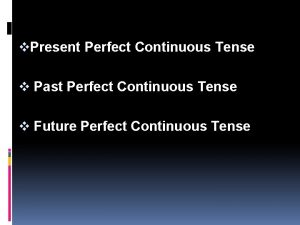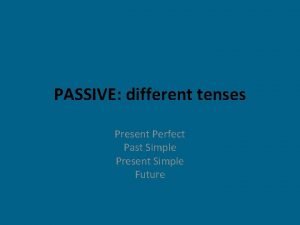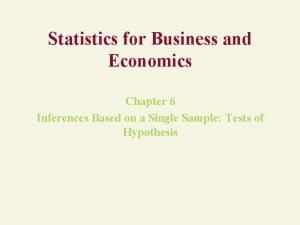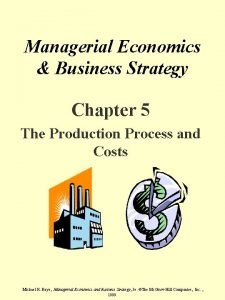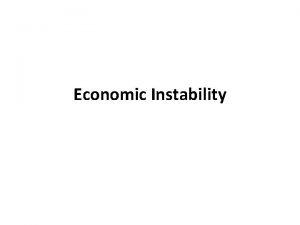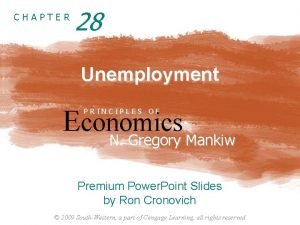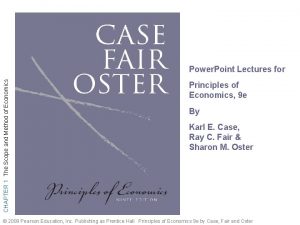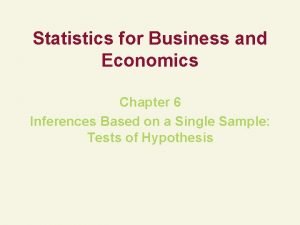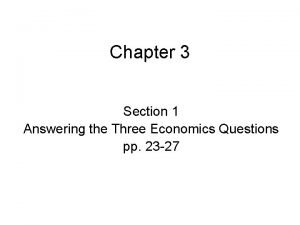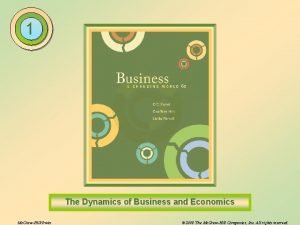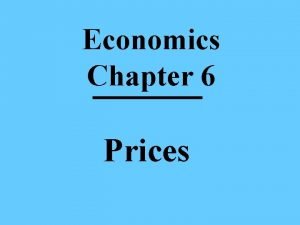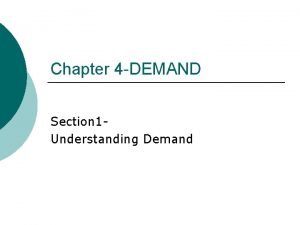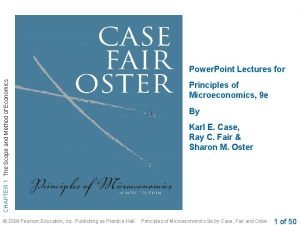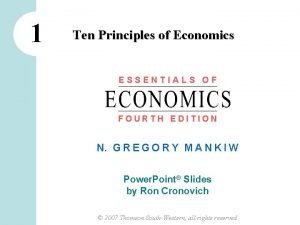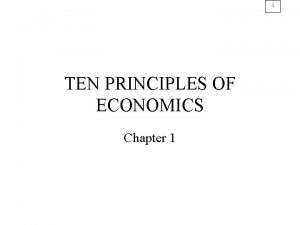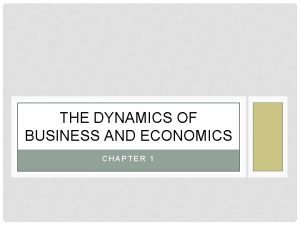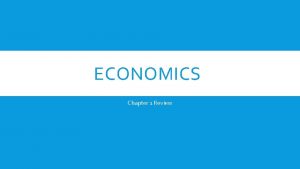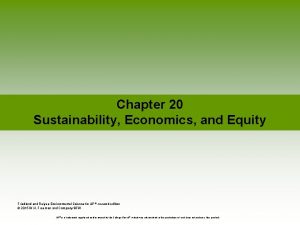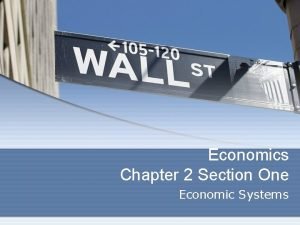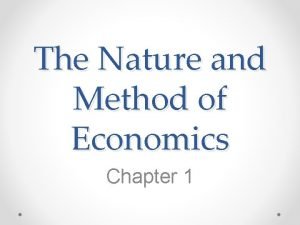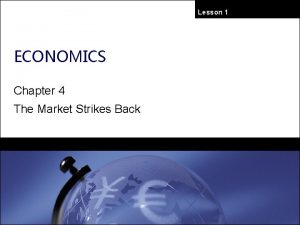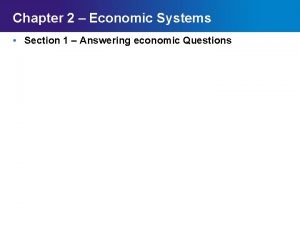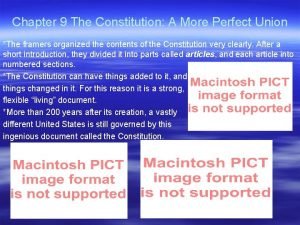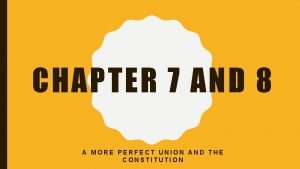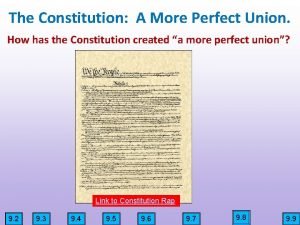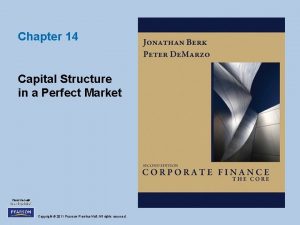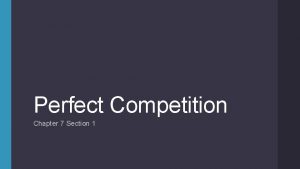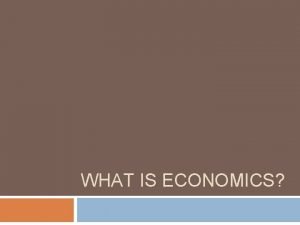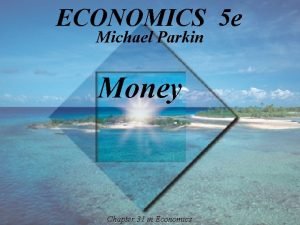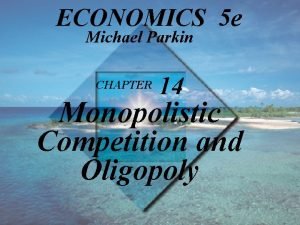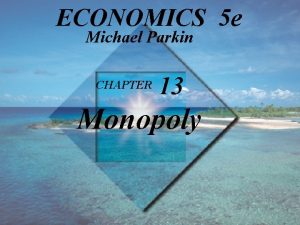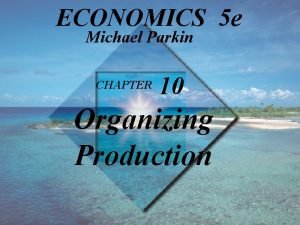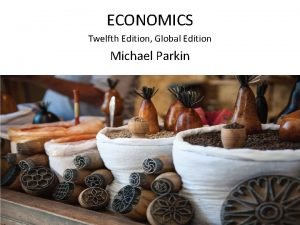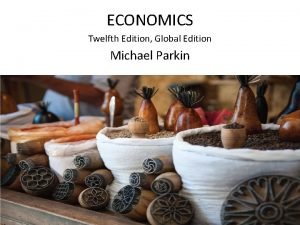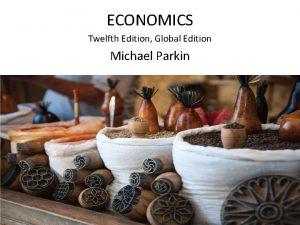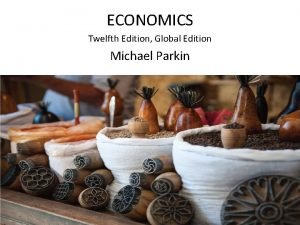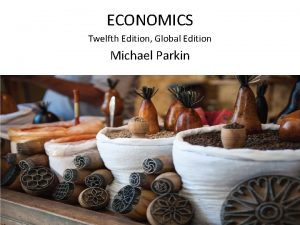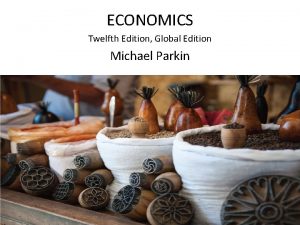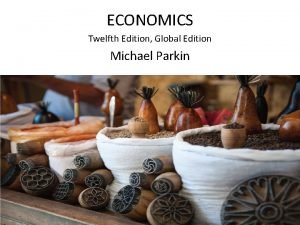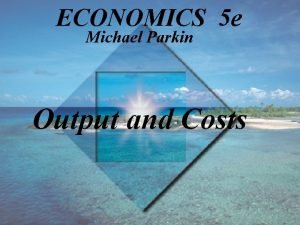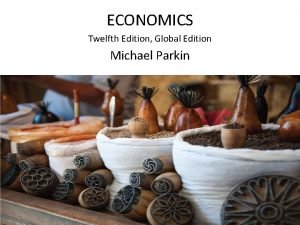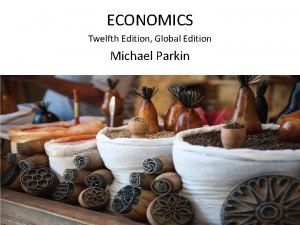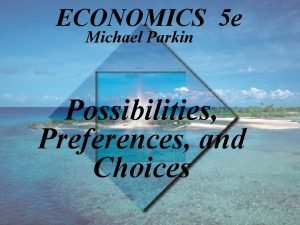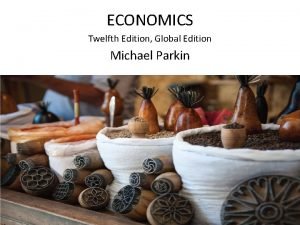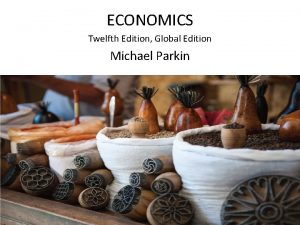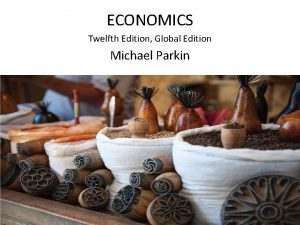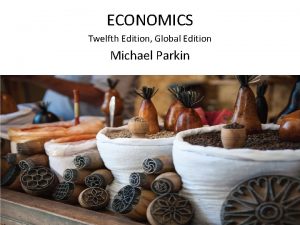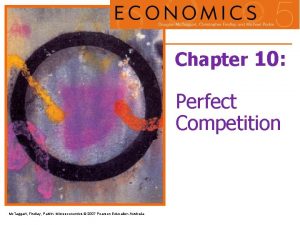ECONOMICS 5 e Michael Parkin CHAPTER 12 Perfect







































































- Slides: 71

ECONOMICS 5 e Michael Parkin CHAPTER 12 Perfect Competition

Learning Objectives • Define perfect competition • Explain how price and output are determined in a competitive industry • Explain why firms sometimes shut down temporarily and lay off workers Copyright © 1998 Addison Wesley Longman, Inc. TM 12 -2

Learning Objectives (cont. ) • Explain why firms enter and leave an industry • Predict the effects of a change in demand of a technological advance • Explain why perfect competition is efficient Copyright © 1998 Addison Wesley Longman, Inc. TM 12 -3

Learning Objectives • Define perfect competition • Explain how price and output are determined in a competitive industry • Explain why firms sometimes shut down temporarily and lay off workers Copyright © 1998 Addison Wesley Longman, Inc. TM 12 -4

Perfect Competition Characteristics of Perfect Competition • Many firms, each selling an identical product. • Many buyers. • No restrictions on entry into the industry. Copyright © 1998 Addison Wesley Longman, Inc. TM 12 -5

Perfect Competition Characteristics of Perfect Competition • Firms in the industry have no advantage over potential new entrants. • Firms and buyers are well informed about prices of the products of each firm in the industry. Copyright © 1998 Addison Wesley Longman, Inc. TM 12 -6

Perfect Competition As a result of these characteristics, perfect competitors are price takers. Price takers Firms that cannot influence the price of a good or service. Copyright © 1998 Addison Wesley Longman, Inc. TM 12 -7

Learning Objectives • Define perfect competition • Explain how price and output are determined in a competitive industry • Explain why firms sometimes shut down temporarily and lay off workers Copyright © 1998 Addison Wesley Longman, Inc. TM 12 -8

Economic Profit and Revenue The firm’s goal is to maximize economic profit. Total cost is the opportunity cost - including normal profit. Copyright © 1998 Addison Wesley Longman, Inc. TM 12 -9

Economic Profit and Revenue Total revenue is the value of a firm’s sales. • Total revenue = P Q Marginal revenue (MR) • Change in total revenue resulting from a one-unit increase in quantity sold. Average revenue (AR) • Total revenue divided by the quantity sold—revenue per unit sold. In perfect competition, Price = MR = AR Copyright © 1998 Addison Wesley Longman, Inc. TM 12 -10

Economic Profit and Revenue Suppose Sidney sells his sweaters in a perfectly competitive market. Copyright © 1998 Addison Wesley Longman, Inc. TM 12 -11

Demand, Price, and Revenue in Perfect Competition Quantity sold (Q) (sweaters per day) Price (P) Total revenue (dollars per TR = P Q sweater) (dollars) 8 25 9 25 10 25 Copyright © 1998 Addison Wesley Longman, Inc. Marginal revenue Average revenue (AR = TR/Q (dollars per additional sweater) (dollars per sweater) TM 12 -12

Demand, Price, and Revenue in Perfect Competition Quantity sold (Q) (sweaters per day) Price (P) Total revenue (dollars per TR = P Q sweater) (dollars) 8 25 200 9 25 225 10 25 250 Copyright © 1998 Addison Wesley Longman, Inc. Marginal revenue Average revenue (AR = TR/Q (dollars per additional sweater) (dollars per sweater) TM 12 -13

Demand, Price, and Revenue in Perfect Competition Quantity sold (Q) (sweaters per day) Price (P) Total revenue (dollars per TR = P Q sweater) (dollars) 8 25 200 9 25 225 10 25 250 Copyright © 1998 Addison Wesley Longman, Inc. Marginal revenue Average revenue (AR = TR/Q (dollars per additional sweater) (dollars per sweater) 25 25 TM 12 -14

Demand, Price, and Revenue in Perfect Competition Quantity sold (Q) (sweaters per day) Price (P) Total revenue (dollars per TR = P Q sweater) (dollars) 8 25 200 9 25 225 10 25 250 Copyright © 1998 Addison Wesley Longman, Inc. Marginal revenue Average revenue (AR = TR/Q (dollars per additional sweater) 25 25 (dollars per sweater) 25 25 25 TM 12 -15

Demand, Price, and Revenue in Perfect Competition Sidney’s demand marginal revenue 50 50 S Market demand curve 25 Sidney’s demand curve MR 25 Sidney’s total revenue Total revenue (dollar per day) Price (dollars per sweater) Sweater market TR a 225 D 0 9 20 Quantity (thousands of sweaters per day) Copyright © 1998 Addison Wesley Longman, Inc. 0 10 20 Quantity (sweaters per day) 0 9 20 Quantity (sweaters per day) TM 12 -16

Learning Objectives • Define perfect competition • Explain how price and output are determined in a competitive industry • Explain why firms sometimes shut down temporarily and lay off workers Copyright © 1998 Addison Wesley Longman, Inc. TM 12 -17

The Firm’s Decisions in Perfect Competition A firm’s task is to make the maximum economic profit possible, given the constraints it faces. In order to do so, the firm must make two decisions in the short-run, and two in the long-run. Copyright © 1998 Addison Wesley Longman, Inc. TM 12 -18

The Firm’s Decisions in Perfect Competition Short-run A time frame in which each firm has a given plant and the number of firms in the industry is fixed Long-run A time frame in which each firm can change the size of its plant and decide to enter the industry. Copyright © 1998 Addison Wesley Longman, Inc. TM 12 -19

The Firm’s Decisions in Perfect Competition In the short-run, the firm must decide: • Whether to produce or to shut down. • If the decision is to produce, what quantity to produce. Copyright © 1998 Addison Wesley Longman, Inc. TM 12 -20

The Firm’s Decisions in Perfect Competition In the long-run, the firm must decide: • Whether to increase of decrease its plant size. • Whether to stay in the industry or leave it. We will first address the short-run. Copyright © 1998 Addison Wesley Longman, Inc. TM 12 -21

Total Revenue, Total Cost, and Economic Profit Quantity Total (Q) revenue (sweaters (TR) Per day) 0 1 2 3 4 5 6 7 8 9 10 11 12 13 Copyright © 1998 Addison Wesley Longman, Inc. (dollars) Total cost (TC) Economic profit (TR – TC) (dollars) 0 25 50 75 100 125 150 175 200 225 250 275 300 325 TM 12 -22

Total Revenue, Total Cost, and Economic Profit Quantity (Q) (sweaters Per day) 0 1 2 3 4 5 6 7 8 9 10 11 12 13 Copyright © 1998 Addison Wesley Longman, Inc. Total revenue (TR) Total cost (TC) Economic profit (TR – TC) (dollars) 0 25 50 75 100 125 150 175 200 225 250 275 300 325 22 45 66 85 100 114 126 141 160 183 210 245 300 360 TM 12 -23

Total Revenue, Total Cost, and Economic Profit Quantity (Q) (sweaters Per day) 0 1 2 3 4 5 6 7 8 9 10 11 12 13 Copyright © 1998 Addison Wesley Longman, Inc. Total revenue (TR) Total cost (TC) Economic profit (TR – TC) (dollars) 0 25 50 75 100 125 150 175 200 225 250 275 300 325 22 45 66 85 100 114 126 141 160 183 210 245 300 360 -22 -20 -16 -10 0 11 24 24 40 42 40 30 0 -35 TM 12 -24

Total revenue & total cost (dollars per day) Total Revenue, Total Cost, and Economic Profit TC TR 300 Economic loss 225 Economic profit = TR - TC 183 100 Economic loss 0 4 9 12 Quantity (sweaters per day) Copyright © 1998 Addison Wesley Longman, Inc. TM 12 -25

Total Revenue, Total Cost, and Economic Profit/loss (dollars per day) Economic profit/loss 42 20 0 4 -20 -40 Copyright © 1998 Addison Wesley Longman, Inc. Economic profit Economic loss Profit maximizing quantity 9 12 Profit/ loss Quantity (sweaters per day) TM 12 -26

Marginal Analysis Using marginal analysis, a comparison is made between a units marginal revenue and marginal cost. Copyright © 1998 Addison Wesley Longman, Inc. TM 12 -27

Marginal Analysis If MR > MC, the extra revenue from selling one more unit exceeds the extra cost. • The firm should increase output to increase profit. If MR < MC, the extra revenue from selling one more unit is less than the extra cost. • The firm should decrease output to increase profit. If MR = MC economic profit is maximized. Copyright © 1998 Addison Wesley Longman, Inc. TM 12 -28

Profit-Maximizing Output Marginal revenue Quantity Total (MR) (Q) revenue (dollars per (sweaters (TR) additional per day) 7 8 9 10 11 (dollars) sweater) Total cost (TC) (dollars Marginal cost (MC) (dollars per additional sweater) Economic profit (TR – TC) (dollars) 175 200 225 250 275 Copyright © 1998 Addison Wesley Longman, Inc. TM 12 -29

Profit-Maximizing Output Marginal revenue Quantity Total (MR) (Q) revenue (dollars per (sweaters (TR) additional per day) 7 8 9 10 11 (dollars) 175 200 225 250 275 Copyright © 1998 Addison Wesley Longman, Inc. sweater) Total cost (TC) (dollars Marginal cost (MC) (dollars per additional sweater) Economic profit (TR – TC) (dollars) 25 25 TM 12 -30

Profit-Maximizing Output Marginal revenue Quantity Total (MR) (Q) revenue (dollars per (sweaters (TR) additional per day) 7 8 9 10 11 (dollars) 175 200 225 250 275 Copyright © 1998 Addison Wesley Longman, Inc. sweater) 25 25 Total cost (TC) (dollars Marginal cost (MC) (dollars per additional sweater) Economic profit (TR – TC) (dollars) 141 160 183 210 245 TM 12 -31

Profit-Maximizing Output Marginal revenue Quantity Total (MR) (Q) revenue (dollars per (sweaters (TR) additional per day) 7 8 9 10 11 (dollars) 175 200 225 250 275 Copyright © 1998 Addison Wesley Longman, Inc. sweater) 25 25 Total cost (TC) (dollars 141 160 183 210 245 Marginal cost (MC) (dollars per additional sweater) Economic profit (TR – TC) (dollars) 19 23 27 35 TM 12 -32

Profit-Maximizing Output Marginal revenue Quantity Total (MR) (Q) revenue (dollars per (sweaters (TR) additional per day) 7 8 9 10 11 (dollars) 175 200 225 250 275 Copyright © 1998 Addison Wesley Longman, Inc. sweater) 25 25 Total cost (TC) (dollars 141 160 183 210 245 Marginal cost (MC) (dollars per additional sweater) 19 23 27 35 Economic profit (TR – TC) (dollars) 34 40 42 40 30 TM 12 -33

Marginal revenue & marginal cost (dollars per day) Profit-Maximizing Output 30 25 20 Profitmaximization point MC Loss from 10 th sweater MR Profit from 9 th sweater 10 0 8 9 10 Quantity (sweaters per day) Copyright © 1998 Addison Wesley Longman, Inc. TM 12 -34

The Firm’s Short-Run Supply Curve Fixed costs must be paid in the short-run. Variable-costs can be avoided by laying off workers and shutting down. Firms shut down if price falls below the minimum of average variable cost. Copyright © 1998 Addison Wesley Longman, Inc. TM 12 -35

Marginal revenue & marginal cost (dollars per day) A Firm’s Supply Curve MC = S 31 MR 2 25 MR 1 Shutdown point AVC s MR 0 17 0 7 9 10 Quantity (sweaters per day) Copyright © 1998 Addison Wesley Longman, Inc. TM 12 -36

Marginal revenue & marginal cost (dollars per day) A Firm’s Supply Curve S 31 25 17 0 s 7 9 10 Quantity (sweaters per day) Copyright © 1998 Addison Wesley Longman, Inc. TM 12 -37

Short-Run Industry Supply Curve Short-run industry supply curve Shows the quantity supplied by the industry at each price when the plant size of each firm and the number of firms remain constant. It is constructed by summing the quantities supplied by the individual firms. Copyright © 1998 Addison Wesley Longman, Inc. TM 12 -38

Industry Supply Curve Price Quantity supplied by Sidney Quantity supplied by industry (dollars (sweaters per sweater) per day) a 17 0 or 7 0 to 7, 000 b 2 8 8, 000 c 25 9 9, 000 d 31 10 10, 000 Copyright © 1998 Addison Wesley Longman, Inc. TM 12 -39

Price (dollars per sweater) Industry Supply Curve 40 S 1 30 20 0 Copyright © 1998 Addison Wesley Longman, Inc. 6 7 8 9 10 Quantity (thousands of sweaters per day) TM 12 -40

Output, Price, and Profit in Perfect Competition Industry demand industry supply determine the market price and industry output. Changes in demand bring changes to short-run industry equilibrium. Copyright © 1998 Addison Wesley Longman, Inc. TM 12 -41

Price (dollars per sweater) Short-Run Equilibrium Increase in demand: price rises and firms increase production S 25 Decrease in demand: price falls and 20 firms decrease production D 2 17 D 1 D 3 0 6 7 8 9 10 Quantity (thousands of sweaters per day) Copyright © 1998 Addison Wesley Longman, Inc. TM 12 -42

Profits and Losses in the Short-Run At short-run equilibrium firms may: • Earn a profit • Break even • Incur an economic loss. Copyright © 1998 Addison Wesley Longman, Inc. TM 12 -43

Profits and Losses in the Short-Run If price equals average total cost a firm breaks even. If price exceeds average total cost, a firm makes an economic profit. If price is less than average total cost, a firm incurs an economic loss. Copyright © 1998 Addison Wesley Longman, Inc. TM 12 -44

Price (dollars per chip) Three Possible Profit Outcomes in the Short-Run 30. 00 25. 00 Normal profit MC Break-even point 20. 00 ATC AR = MR 15. 00 0 Copyright © 1998 Addison Wesley Longman, Inc. 8 10 Quantity (millions of chips per year) TM 12 -45

Price (dollars per chip) Three Possible Profit Outcomes in the Short-Run 30. 00 Economic profit MC ATC 25. 00 AR = MR Economic Profit 20. 33 15. 00 0 9 10 Quantity (millions of chips per year) Copyright © 1998 Addison Wesley Longman, Inc. TM 12 -46

Price (dollars per chip) Three Possible Profit Outcomes in the Short-Run Economic loss 30. 00 MC ATC 25. 00 20. 14 17. 00 0 Copyright © 1998 Addison Wesley Longman, Inc. Economic loss AR = MR 7 10 Quantity (millions of chips per year) TM 12 -47

Learning Objectives (cont. ) • Explain why firms enter and leave an industry • Predict the effects of a change in demand of a technological advance • Explain why perfect competition is efficient Copyright © 1998 Addison Wesley Longman, Inc. TM 12 -48

Long-Run Adjustments Forces in a competitive industry ensure only one of these situations is possible in the long -run. Competitive industries adjust in two ways: • Entry and exit • Changes in plant size Copyright © 1998 Addison Wesley Longman, Inc. TM 12 -49

Entry and Exit The prospect of persistent profit or loss causes firms to enter or exit an industry. If firms are making economic profits, other firms enter the industry. If firms are making economic losses, some of the existing firms exit the industry. Copyright © 1998 Addison Wesley Longman, Inc. TM 12 -50

Entry and Exit This entry and exit of firms influence price, quantity, and economic profit. Let’s investigate the effects of firms entering or exiting an industry. Copyright © 1998 Addison Wesley Longman, Inc. TM 12 -51

Price (dollars per sweater) Entry and Exit Entry increases supply S 1 S 0 S 2 23 Exit decreases supply 20 17 D 1 0 6 7 8 9 10 Quantity (thousands of sweaters per day) Copyright © 1998 Addison Wesley Longman, Inc. TM 12 -52

Entry and Exit Important Points As new firms enter an industry, the price falls and the economic profit of each existing firm decreases. As firms leave an industry, the price rises and the economic loss of each remaining firm decreases. Copyright © 1998 Addison Wesley Longman, Inc. TM 12 -53

Changes in Plant Size When a firm changes its plant size, it can lower its costs and increase its economic profit. Let’s see how a firm can increase its profit by increasing its plant size. Copyright © 1998 Addison Wesley Longman, Inc. TM 12 -54

Price (dollars per sweater) Plant Size and Long-Run Equilibrium Short-run profit maximizing point 40 MC 0 SRAC 0 LRAC MC 1 SRAC 1 25 20 m 14 6 Copyright © 1998 Addison Wesley Longman, Inc. MR 0 MR 1 Long-run competitive equilibrium 8 Quantity (sweaters per day) TM 12 -55

Long-Run Equilibrium Long-run equilibrium occurs in a competitive industry when firms are earning normal profit and economic profit is zero. Economic profits draw in firms and cause existing firms to expand. Economic losses cause firms to leave and cause existing firms to scale back. Copyright © 1998 Addison Wesley Longman, Inc. TM 12 -56

Long-Run Equilibrium So in long-run equilibrium in a competitive industry, firms neither enter nor exit the industry and firms neither expand their scale of operation nor downsize. Copyright © 1998 Addison Wesley Longman, Inc. TM 12 -57

Learning Objectives (cont. ) • Explain why firms enter and leave an industry • Predict the effects of a change in demand of a technological advance • Explain why perfect competition is efficient Copyright © 1998 Addison Wesley Longman, Inc. TM 12 -58

Changing Tastes and Advancing Technology Demand has fallen tremendously for tobacco, trains, TV and radio repair, and sewing machines. Demand has increased dramatically for microwave utensils, paper plates, and flash memories. Copyright © 1998 Addison Wesley Longman, Inc. TM 12 -59

Changing Tastes and Advancing Technology What happens in a competitive industry when a permanent change in demand occurs? Copyright © 1998 Addison Wesley Longman, Inc. TM 12 -60

A Decrease in Demand S 1 Firm S 0 Price and Cost Price Industry P 0 P 1 MC ATC MR 0 MR 1 D 0 D 1 0 Q 2 Q 1 Copyright © 1998 Addison Wesley Longman, Inc. Q 0 Quantity q 1 q 0 Quantity TM 12 -61

External Economies and Diseconomies External economies Factors beyond the control of an individual firm that lower its costs as the industry increases. External diseconomies Factors outside the control of a firm that raise the firm’s costs as industry output increases. Copyright © 1998 Addison Wesley Longman, Inc. TM 12 -62

External Economies and Diseconomies We will use this information to develop a long-run industry supply curve. Copyright © 1998 Addison Wesley Longman, Inc. TM 12 -63

Long-Run Changes in Price and Quantity Decreasing-cost industry Price Increasing-cost industry Price Constant-cost industry S 0 Ps S 1 LSA P 0 S 2 LSB Ps S 0 Ps P 2 P 0 D 1 D 0 Qs Q 1 Quantity Copyright © 1998 Addison Wesley Longman, Inc. Q 0 D 0 Qs Q 2 Quantity S 0 S 3 P 0 P 3 LSC D 1 Q 0 Qs D 0 Q 3 Quantity TM 12 -64

Changing Tastes and Advancing Technology Technological change New technology allows firms to produce at lower costs. This causes their cost curves to shift downward. Firms adopting the new technology make an economic profit. This draws in new technology firms. Old technology firms disappear, the price falls, and the quantity produced increases. Copyright © 1998 Addison Wesley Longman, Inc. TM 12 -65

Learning Objectives (cont. ) • Explain why firms enter and leave an industry • Predict the effects of a change in demand of a technological advance • Explain why perfect competition is efficient Copyright © 1998 Addison Wesley Longman, Inc. TM 12 -66

Competition and Efficiency Resources are used efficiently when there is: • Consumer efficiency • Producer efficiency • Exchange efficiency Copyright © 1998 Addison Wesley Longman, Inc. TM 12 -67

Competition and Efficiency Consumer efficiency is achieved when it is not possible for consumers to become better off — to increase utility — by reallocating their budgets. • On the household’s demand curve • External benefits Producer efficiency occurs when a firm is producing at any point on its marginal cost curve, or equivalently, on its supply curve. • External costs Copyright © 1998 Addison Wesley Longman, Inc. TM 12 -68

Competition and Efficiency Exchange efficiency occurs when all the gains from trade have been realized (i. e. consumer and producer surplus). Copyright © 1998 Addison Wesley Longman, Inc. TM 12 -69

Efficiency of Competition Price S B 0 P* Consumer surplus Efficient allocation Producer surplus C 0 D Q 0 Copyright © 1998 Addison Wesley Longman, Inc. Q* Quantity TM 12 -70

Efficiency of Perfect Competition Perfect competition enables resources to be used efficiently if there are no external benefits and external costs. • External costs and external benefits • Goods providing external benefits would be underproduced, while goods providing external costs would be overproduced. • Monopoly restricts output below its competitive level to raise price and increase profit. Copyright © 1998 Addison Wesley Longman, Inc. TM 12 -71
 Macroeconomics michael parkin 13th edition
Macroeconomics michael parkin 13th edition Parkin economics 12th edition
Parkin economics 12th edition Escala de parkin
Escala de parkin Parkin banking private services
Parkin banking private services Julie parkin
Julie parkin Perfect present
Perfect present Maastricht university economics and business economics
Maastricht university economics and business economics Elements of mathematical economics
Elements of mathematical economics Philosophy, politics and economics michael munger
Philosophy, politics and economics michael munger Change to present perfect tense
Change to present perfect tense Chapter 3 perfect and perfect progressive tenses
Chapter 3 perfect and perfect progressive tenses Past simple present perfect present perfect continuous
Past simple present perfect present perfect continuous Ernie / break / his leg / four times
Ernie / break / his leg / four times Present perfect simple and continuous difference
Present perfect simple and continuous difference Simple past vs present continuous
Simple past vs present continuous Past perfect vs past perfect progressive
Past perfect vs past perfect progressive Past simple past perfect and past continuous
Past simple past perfect and past continuous Past perfect simple πως σχηματιζεται
Past perfect simple πως σχηματιζεται Future continuous future perfect exercises
Future continuous future perfect exercises Past perfect vs past simple vs past continuous
Past perfect vs past simple vs past continuous Perfect infinitive passive
Perfect infinitive passive Nadar present perfect
Nadar present perfect Present perfect tense of play
Present perfect tense of play Time expression for present perfect continuous
Time expression for present perfect continuous Keywords present perfect
Keywords present perfect Is 1728 a perfect square
Is 1728 a perfect square Past simple (i did) unit 5
Past simple (i did) unit 5 Present perfect progressive meaning
Present perfect progressive meaning Present perfect tense vs present perfect continuous tense
Present perfect tense vs present perfect continuous tense Present perfect simple
Present perfect simple Present perfect and present progressive
Present perfect and present progressive Function past perfect
Function past perfect Tenses in a nutshell
Tenses in a nutshell Future perfect simple vs future perfect continuous
Future perfect simple vs future perfect continuous Present perfect continuous auxiliary verb
Present perfect continuous auxiliary verb Subjunctive present perfect
Subjunctive present perfect Have been ving
Have been ving Present perfect passive
Present perfect passive Past perfect vs past perfect continuous
Past perfect vs past perfect continuous Perfect future continuous tense
Perfect future continuous tense One proportion z test
One proportion z test Ecomics
Ecomics Chapter 13 economic instability
Chapter 13 economic instability Chapter 28 unemployment
Chapter 28 unemployment The scope and method of economics chapter 1
The scope and method of economics chapter 1 What is the ha
What is the ha Economics chapter 3 section 1 answer key
Economics chapter 3 section 1 answer key Chapter 1 ten principles of economics
Chapter 1 ten principles of economics Chapter 1 the dynamics of business and economics
Chapter 1 the dynamics of business and economics Environmental science chapter 2
Environmental science chapter 2 Chapter 6 section 1 economics
Chapter 6 section 1 economics Economics chapter 4 section 1 understanding demand answers
Economics chapter 4 section 1 understanding demand answers Fundamentals of managerial economics
Fundamentals of managerial economics The scope and method of economics chapter 1
The scope and method of economics chapter 1 One of the ten principles of economics in chapter 1
One of the ten principles of economics in chapter 1 Ten principles of economics chapter 1
Ten principles of economics chapter 1 Chapter 1 the dynamics of business and economics
Chapter 1 the dynamics of business and economics Economics chapter 1 review
Economics chapter 1 review Apes chapter 20 sustainability economics and equity
Apes chapter 20 sustainability economics and equity Economics chapter 2 section 3
Economics chapter 2 section 3 The scope and method of economics chapter 1
The scope and method of economics chapter 1 Discuss the nature and scope of managerial economics
Discuss the nature and scope of managerial economics Chapter 4 lesson 1 what is demand
Chapter 4 lesson 1 what is demand Economics chapter 4 demand
Economics chapter 4 demand Economics chapter 2 section 3 assessment answers
Economics chapter 2 section 3 assessment answers Four perfect pebbles chapter 2
Four perfect pebbles chapter 2 Chapter 9 the constitution a more perfect union
Chapter 9 the constitution a more perfect union Chapter 7 a more perfect union test answers
Chapter 7 a more perfect union test answers Chapter 7 a more perfect union answer key
Chapter 7 a more perfect union answer key Chapter 14 capital structure in a perfect market
Chapter 14 capital structure in a perfect market Chapter 7 section 1 perfect competition worksheet answers
Chapter 7 section 1 perfect competition worksheet answers What economics is
What economics is

